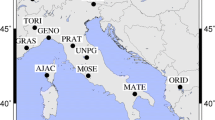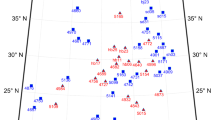Abstract
Recently undifferenced Precise Point Positioning (PPP) technique has become a subject of interest not only among researchers, but also satellite positioning practitioners like surveyors and engineers. Along with the development of precise clocks and orbits products, and the improvement of models mitigating interfering phenomena like atmospheric refraction, PPP has become an alternative to relative positioning in many field applications. This study concerns the usability of Undifferenced Positioning techniques in establishing geodetic control networks. Satellite observations from 13 stations equipped with high-end receivers and survey grade commercial receivers were processed using the NAvigation Package for Earth Observation Satellites -NAPEOS v. 3.3.1. In the study the standard PPP (float) and Undifferenced Network solution with clocks/orbits fixed strategies of post-processing were carried out using various observing intervals (30 min., 1 h, 2 h, 4 h, daily). The high accuracy results obtained with PPP and UD Network solution predisposes these strategies for the use in surveying tasks requiring even centimeter positioning accuracy.
Similar content being viewed by others
References
Araszkiewicz A., Bogusz J., Figurski M., Szafranek K., 2010. Application of short-time GNSS solutions to geodynamical studies. Acta Geodyn. Geomat., 7, 295–302.
Banville S., 2016. GLONASS ionosphere-free ambiguity resolution for precise point positioning. J. Geodesy. 90, 487–496.
Blewitt G., 1989. Carrier phase ambiguity resolution for the global positioning system applied to geodetic baselines up to 2000 km. J. Geophys. Res., 94(B8), 10187–10203.
Boucher C. and Altamimi Z., 2011. Memo: Specifications for Reference Frame Fixing in the Analysis of a EUREF GPS Campaign. http://etrs89.ensg.ign.fr/memo-V8.pdf.
Cai C. and Gao Y., 2007. Precise point positioning using combined GPS and GLONASS observations. Journal of Global Positioning System, 6, 13–22.
Chen J., Xiao P., Zhang Y. and Wu B., 2013. GPS/GLONASS System bias estimation and application in GPS/GLONASS combined positioning. In: Sun J., Jiao W., Wu H. and Shi C. (Eds), China Satellite Navigation Conference (CSNC) 2013 Proceedings. Lecture Notes in Electrical Engineering, 244. Springer, Heidelberg, Germany, 323–333.
Chen W., Hu C.W., Gao S., Chen Y.Q. and Ding X.L., 2009. Error correction models and their effects on GPS precise point positioning. Surv. Rev., 41, 238–252.
Choy S., Zhang S., Lahaye F. and Héroux P., 2013. A comparison between GPS-only and combined GPS +GLONASS precise point positioning. J. Spat. Sci., 58, 169–190.
Chuang S., Wenting Y., Weiwei S., Yidong L., Yibin Y. and Rui A., 2013. GLONASS pseudorange inter-channel biases and their effects on combined GPS/GLONASS precise point positioning. GPS Solut., 17, 439–451.
Collins P., 2008. Isolating and estimating undiferenced GPS integer ambiguities. Proceedings of the 2008 National Technical Meeting of the Institute of Navigation, January 28–30, 2008. 720–732.
Dong D. and Bock Y., 1989. Global positioning system network analysis with phase ambiguity resolution applied to crustal deformation studies in California. J. Geophys. Res., 94(B4), 3949–3966.
El-Mowafy A., 2009. Alternative postprocessing relative positioning approach based on precise point positioning J. Surv. Eng., 135(2), 56–65.
El-Rabbany A., 2006. Introduction to GPS: The Global Positioning System, Second Edition. Artech House, Toronto, Canada
Ge M., Gendt G., Rothacher M., Shi C. and Liu J., 2008. Resolution of GPS carrier-phase ambiguities in precise point positioning (PPP) with daily observations. J. Geodesy, 82, 389–399.
Geng J., Teferle F.N., Shi C., Meng X., Dodson A.H. and Liu J., 2009. Ambiguity resolution in precise point positioning with hourly data. GPS Solut., 13, 263–270.
Geng J., Meng X., Teferle F.N. and Dodson A.H., 2010. Performance of precise point positioning with ambiguity resolution for 1-to 4-hour observation periods. Surv. Rev., 42, 155–165.
Guo F., Zhang X.H. and Wang J., 2015. Timing group delay and differential code bias corrections for BeiDou positioning. J. Geodesy, 89, 427–445.
Han S.C., Kwon J.H. and Jekeli C., 2001. Accurate absolute GPS positioning through satellite clock error estimation. J. Geodesy, 77, 33–43.
Hazewinkel M., 1994. Orthogonalization. In: Hazewinkel M. (Ed.), Encyclopedia of Mathematics. Springer, Dordrecht, The Netherlands, ISBN 978-1-55608-010-4.
Hofmann-Wellenhof B., Lichtenegger H. and Collins J., 2003. Global Positioning System: Theory and Practice. Springer, New York.
Jin S., Park J.U., Cho J.H. and Park P.H., 2007. Seasonal variability of GPS-derived zenith tropospheric delay (1994–2006) and climate implications. J. Geophys. Res., 112, DOI: 10.1029/2006JD007772.
Khodabandeh A. and Teunissen P.J.G., 2015. An analytical study of PPP-RTK corrections: precision, correlation and user-impact. J. Geodesy, 89, 1109–1132.
Khodabandeh A. and Teunissen P.J.G., 2016. PPP-RTK and inter-system biases: the ISB look-up table as a means to support multi-system PPP-RTK. J. Geodesy, 90, 837–851.
Kouba J. and Heroux P., 2001. Precise point positioning using IGS orbit and clock products. GPS Solut., 5(2), 12–28.
Kouba J., 2009. A Guide to Using International GNSS Service (IGS) Products. Geodetic Survey Division, Natural Resources Canada (http://igscb.jpl.nasa.gov/igscb/resource/pubs /UsingIGSProductsVer21.pdf).
Laurichesse D., Mercier F., Berthias J. P., Broca P. and Cerri L., 2007. Integer ambiguity resolution on undiferenced GPS phase measurements and its application to PPP. Proceedings of the 20th International Technical Meeting of the Satellite Division of The Institute of Navigation (ION GNSS 2007), 839–848.
Montenbruck O. and Hauschild A., 2014. Differential code bias estimation using multi-GNSS observations and global ionosphere maps. Proceedings of the ION-ITM 2014, San Diego, CA, 802–812.
Odijk D. and Teunissen P.J.G., 2013. Characterization of between-receiver GPS-Galileo intersystem biases and their effect on mixed ambiguity resolution. GPS Solut., 17(4), 521–533.
Paziewski J., Sieradzki R. and Wielgosz P., 2015. Selected properties of GPS and Galileo-IOV receiver intersystem biases in multi-GNSS data processing. Meas. Sci. Technol., 26, 95008–95016
Pei X., Chen J., Wang J., Zhang Y. and Li H., 2012. Application of inter-system hardware delay bias in GPS/GLONASS PPP. In: Sun J., Liu J., Yang Y. and Fan S. (Eds), China Satellite Navigation Conference (CSNC) 2012 Proceedings. Lecture Notes in Electrical Engineering, 160, Springer, Heidelberg, Germany, 381–387.
Petit G. and Luzum B., 2010. IERS Conventions 2010. IERS Technical Note 36, Verlag des Bundesamts fuer Kartographie und Geodaesie, Frankfurt am Main, Germany.
Rabbou M.A. and El-Rabbany A., 2015. PPP accuracy enhancement using GPS/GLONASS observations in kinematic mode. Positioning, 6(1), 1–6.
Reussner N. and Wanninger L., 2011. GLONASS inter-frequency biases and their effects on RTK and PPP carrier-phase ambiguity resolution. Proceedings of the ION GNSS 2011, Portland, Oregon, 712–716.
Roberts G.W., Tang X. and Brown Ch., 2015. A review of satellite positioning systems for civil engineering. Proc. Inst. Civil Eng.-Civil Eng., 168, 185–192.
Shi Ch., Yi W., Song W., Lou Y., Yao Y. and Zhang R., 2013. GLONASS pseudorange interchannel biases and their effects on combined GPS/GLONASS precise point positioning. GPS Solut., 17(4), 439–451.
Springer T.A., 2009. NAPEOS Mathematical Models and Algorithms, DOPS-SYS-TN-0100-OPSGN, issue 1.0. European Space Operation Center, ESA, Darmstadt, Germany.
Teunissen P.J.G. and Khodabandeh A., 2015. Review and principles of PPP-RTK methods. J. Geodesy, 89, 217–240.
Wang F., Chen X. and Guo F., 2015. GPS/GLONASS combined precise point positioning with receiver clock modeling. Sensors, 15, 15478–15493.
Wanninger L., 2012. Carrier-phase inter-frequency biases of GLONASS receivers. J. Geodesy, 86, 139–148.
Author information
Authors and Affiliations
Corresponding author
Rights and permissions
About this article
Cite this article
Krzan, G. The usability of the undifferenced positioning techniques in establishing regional geodetic control networks: a case study in Poland. Stud Geophys Geod 62, 17–37 (2018). https://doi.org/10.1007/s11200-016-0585-2
Received:
Revised:
Accepted:
Published:
Issue Date:
DOI: https://doi.org/10.1007/s11200-016-0585-2




